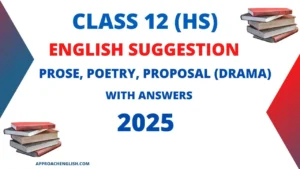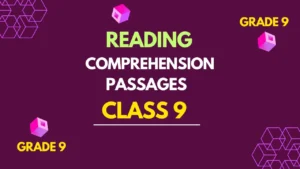3 Continuous Tenses Uses Structure Worksheets for Class 6 exercises focus on present continuous, past continuous, and future continuous tenses. These worksheets typically offer structured activities.
The Continuous Tenses Worksheets for Class 6 contain completing sentences, transforming sentences from one tense to another, and identifying the correct tense for given contexts.
3 Continuous Tenses Uses Structure Worksheets for Class 6 are designed to enhance Class 6 students’ understanding of the uses and structures of continuous tenses, reinforcing grammar skills and application.
3 Continuous Tenses Uses Structure Worksheets for Class 6
The Continuous Tense, also known as the Progressive Tense, indicates ongoing actions or progress at a specific point in time.
It has three forms:
I. Present Continuous
II. Past Continuous
III. Future Continuous
English Grammar Ebook for Class 6
I. Present Continuous Tense
The present continuous tense tells us about an action that is taking place at the time of speaking.
Let’s get started for the present continuous tense with the following:
A. Uses of Present Continuous Tense
B. Structure of Present Continuous Tense
C. Comparison between Simple Present tense and Present Continuous Tense
A. Uses of Present Continuous Tense
The present continuous tense is used
(i) to describe an action that is happening at the time of speaking.
For example,
- Ipsita is eating her breakfast.
- I am writing a letter to the editor of our school magazine.
- I am currently typing a response to your question.
- She is talking on the phone with her friend right now.
- We are watching a movie together this evening.
(ii) to describe an action that has been going on over a period of time, including the present, but may not be happening at the time of speaking.
For example,
- Akshay is learning French and German.
- Mohan and Rajat are working on a project on ‘Global Warming.
- They are currently building a new bridge that will connect the two cities.
- She is learning to play the guitar these days, but she’s not practicing right now.
- He is taking evening classes to improve his English, but he’s not attending one at the moment.
(iii) to describe a future plan.
For example,
- My sister is arriving by the 7 o’clock train tonight.
- They are leaving for Jaipur tomorrow.
- We are meeting for lunch tomorrow at noon.
- They are flying to Paris next week for their vacation.
- She is attending a conference next month to present her research findings.
B. Structure of Present Continuous Tense
The Structure of Present Continuous Tense varies depending on whether the sentence is:
a. Affirmative
b. Negative
c. Interrogative
d. Negative-Interrogative.
a. Affirmative sentences
For affirmative sentences in the present continuous tense, we use the present
participle form of the verb.
| Structure: subject + am/is/are + verb + ing + rest of the sentence. |
For example,
- I am playing football.
- Shiela is baking cookies.
- They are singing loudly.
b. Negative sentences
For negative sentences, we have the following structure.
| Structure: subject + am/is/are + not + verb + ing + rest of the sentence. |
For example,
- I am not watching television.
- She is not staying in Scotland.
- We are not making any noise.
c. Interrogative sentences
For interrogative sentences, we have the following structure.
| Structure: Am/Is/Are + not + verb + ing + rest of the sentence? |
For example,
- Are you speaking to me?
- Is he waiting for Tripti?
- Am I going to help you?
d. Negative-Interrogative Sentences
| Structure: Am/Is/Are + subject(pronoun) + not + verb + ing + rest of the sentence? Structure: Am/Is/Are + not + subject(noun) + verb + ing + rest of the sentence? |
For example,
- Is she not coming to the party?
- Are you not feeling well?
- Is not Rita doing her homework?
- Is it not raining outside?
- Are not Jimmy and Smith standing there now?
C. Comparison: Simple Present Tense and Present Continuous Tense
| Simple present tense | Present continuous tense |
| describes a habitual action. For example,I go to the playground with my friends every evening. | describes an action going on at the time of speaking. For example,I am going to the playground with my friends now. |
| Time expressions used are:every day, never, always, sometimes, usually, often. For example,I usually leave for school at 6:50 a.m. | Time expressions used are: now, today, at the moment. For example,I am leaving for school now. |
II. Past Continuous Tense
The past continuous tense tells us about an action that was taking place at the time of speaking in the past.
We will start discussing Past continuous tense with the following:
A. Uses of Past Continuous Tense
B. Structure of Past Continuous Tense
C. Comparison between Simple Past tense and Past Continuous Tense
A. Uses of Past Continuous Tense
The past continuous tense is used
(i) to describe an unfinished action that was interrupted by another event or action.
For example,
- I was watching TV when you called.
- I was making my presentation, when the computer went off.
(ii) to describe two actions that were happening at the same time in the past.
For example,
- While Mother was cooking, I was watching television.
- While Maya was reading, Rajat was watering the plants.
(iii) to describe the introductory scene for a story written in the past tense.
For example,
- The sun was shining brightly.
- The birds were chirping on the trees.
B. Structure of Past Continuous Tense
The Structure of Past Continuous Tense varies depending on whether the sentence is:
a. Affirmative
b. Negative
c. Interrogative
d. Negative-Interrogative.
a. Affirmative sentences
For affirmative sentences in the past continuous tense, we use the present participle form of the verb.
| Structure: subject + was/were + verb + ing + rest of the sentence. |
For example,
- We were sleeping in the afternoon.
- She was watching television.
- The children were playing in the garden.
b. Negative Sentences
For negative sentences, we have the following structure.
| Structure: subject + was/were + not + verb + ing + rest of the sentence. |
For example,
- He was not waiting for us.
- She was not driving carefully.
- The students were not making any noise.
c. Interrogative sentences
For interrogative sentences, we have the following structure.
| Structure: Was/Were + not + verb + ing + rest of the sentence? |
For example,
- Was she singing a song?
- Were they decorating the Christmas tree?
- Was she sleeping?
d. Negative-Interrogative Sentences
| Structure: Was/Were + subject(pronoun) + not + verb + ing + rest of the sentence? Structure: Was/Were + not + subject(noun) + verb + ing + rest of the sentence? |
For example,
- Was he not working on the project?
- Were they not studying for the exam?
- Wasn’t it raining when you left?
- Weren’t Rita and Mita sleeping when I called?
- Wasn’t Som cooking dinner when you arrived?
Comparison: Simple Past Tense and Past Continuous Tense Simple past tense
| Simple past tense | Past continuous tense |
| describes an action that happened in the past. For example,I woke up early today. | describes an action that was in progress at a particular point of time in the past. For example,At 8 p.m. last night, I was studying Maths. |
| Time expressions used are yesterday, last Sunday, last Monday, last month, last year, often. For example,My mother cooked a tasty dinner yesterday. | Time expressions used are: at 6 last night, at 9 yesterday morning, at the moment. For example,I was watching TV at 6 p.m. yesterday. |
III. Future Continuous Tense
The future continuous tense is used to refer to an unfinished action or an action that will be in progress in the future.
Now, we will analyze Future continuous tense with the following:
A. Uses of Future Continuous Tense
B. Structure of Future Continuous Tense
A. Uses of future continuous tense
The future continuous tense is used
(i) to talk about situations and events that will be in progress at a time in the future.
For example,
- This time, next week, I will be holidaying in Dubai.
- Next Monday, Ryan will be joining his new office.
(ii) to talk about a single action which will happen because it is part of a bigger plan or schedule.
For example,
- Ryan and his friends will be leaving for Melbourne tomorrow evening.
- Simi and I will be working late tomorrow to finish the flyers for the fest.
(iii) to talk about an action that will begin now and continue into the future.
For example,
- They will be practising for the match till 8 o’clock.
- Karuna will be studying until she completes the syllabus.
B. Structure of Future Continuous Tense
The Structure of Future Continuous Tense varies depending on whether the sentence is:
a. Affirmative
b. Negative
c. Interrogative
d. Negative-Interrogative.
a. Affirmative sentences
For affirmative sentences in the future continuous tense, we use the present participle form of the verb.
| Structure: subject + shall/will + be + verb + ing + rest of the sentence. |
For example,
- You will be joining the new office next week.
- She will be singing at the party tonight.
b. Negative sentences
For negative sentences, we have the following structure.
| Structure: subject + shall/will + not + be + verb + ing + rest of the sentence. |
For example,
- He will not be going to school tomorrow.
- Father will not be cooking lunch for us.
c. Interrogative sentences
For interrogative sentences, we have the following structure.
| Structure: Shall/Will + subject + be + verb + ing + rest of the sentence? |
For example,
- Will she be waiting for us?
- Will the girls be completing the homework?
d. Negative-Interrogative Sentences
For negative-interrogative sentences, we have the following structure.
| Structure: Shall/Will + subject(pronoun) + not + be + verb + ing + rest of the sentence? |
| Structure: Shall/Will + not + subject(noun) + be + verb + ing + rest of the sentence? |
For example,
- Will she not be waiting for us?
- Will not the girls be completing the homework?
Class 6 English Grammar Chapter-Wise Contents:
3: Nouns
5: Gender
6: Case
7: Pronouns
8: Verbs
10: Adjectives
12: Adverbs
13: The Simple Tense
17: Prepositions
18: Conjunctions
19: Articles
22: Direct and Indirect Speech
Worksheets of the Continuous Tense
Worksheets on the Continuous Tense typically provide exercises where learners fill in the blanks or complete sentences using the correct form of verbs in the continuous tense. 3 Continuous Tenses Uses Structure Worksheets for Class 6 help reinforce understanding of how to form and use the continuous tense in various contexts, improving language proficiency and accuracy.
Worksheet 1:
A. Fill in the blanks with the simple present or the present continuous form of the verbs given in the brackets.
1. Jack …………. (have) a sore throat. He …………. (say) he …………. (feel) feverish too.
2. The rain …………. (come) in through the crack in the windowpane.
3. Anushka …………. (trouble) me a lot. She (begin) to sing when I …………. (do) my homework.
4. The Ganga …………. (flow) through many parts of India. It …………. (flood) quite often, but …………. (make) the soil fertile.
5. Tanya …………. (like) to sketch and draw. Right now, she …………. (paint) a portrait
6. Deepika …………. (love) to read biographies. At the moment, she …………. (read) a biography of M G Ramachandran.
7. I can see the cowse …………. (graze) on the green grass of the pastures.
8. Puneet said, ‘I …………. (go) on a trek to the hills.’
Worksheet 2:
B. Fill in the blanks with the Simple Present or the Present Continuous form of the verbs given in the brackets.
1. Mala …………. (want) to improve her English. She …………. (make) an effort to meet more people and …………. (practise) her speaking skills. Her teacher …………. (give) her extra classes.
The classes …………. (begin) after lunch and …………. (continue) till tea time. Mala …………. (hope) that her marks will improve. She …………. (aim) for a score of 60 per cent.
2. Today …………. (be) the third day of my trek around the Valley of Flowers. I …………. (be) tired. My legs …………. (shake), my feet …………. (hurt) and my toes …………. (bleed), but I …………. (want) to continue. I am …………. (try) to adapt to the high altitude. I am …………. (learn) a little bit about the flowers found here; unfortunately, I not learn …………. (learn, not) about flora quickly. I believe I …………. (improve) gradually. I …………. (travel, currently) with Akash, a student from Xavier Boy’s School in Mumbai. He …………. (be) sweet, but impatient. He always …………. (walk) behind me and …………. (complain) that I am too fast.
Worksheet 3:
C. Fill in the blanks with the simple past tense or the past continuous tense of the verbs in the brackets.
1. My brother …………. (wait) for me at the airport when my plane …………. (land).
2. Faisal …………. (hurt) his finger while he …………. (hammer) a nail into the box.
3. The power …………. (go) off while I …………. (watch)the film.
4. It …………. (begin) to rain when we …………. (play) the finals.
5. I …………. (come) across many interesting pictures when I …………. (surf) the Internet.
6. The boys …………. (steal) mangoes when the watchman …………. (see) them.
7. It …………. (begin) to rain when we …………. (wait)at the bus stop.
Worksheet 4:
D. Change the verbs in these sentences into the future continuous tense.
1. The heat is suffocating.
2. They were singing a song.
3. We are enjoying the party.
4. They are watching TV.
5. She is washing the car.
6. The plaster of the old house is crumbling.
7. He is pestering me with questions. we
8. She is painting the setting sun.
9. She is looking after her sister’s dog.
10. They are getting married on Sunday.
Worksheet 5:
E. Using these time expressions, practice making sentences in the present, past, and future continuous tenses with your partner.
a. past continuous tense
yesterday at 9 a.m.
last week on Sunday
at 4 p.m. last Monday
three years ago in May
b. present continuous tense
now
at the moment
at present
today
tonight
this morning/
afternoon/evening
this week/month/year
while
c. future continuous tense
next week/month/
year
later
this afternoon
tonight/tomorrow
soon
on Saturday
at the weekend







